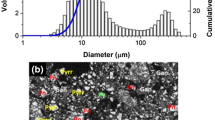Abstract
A 3 M ferrous chloride solution of pH 1.5 and operated at 72° C was found suitable to electro-oxidize nickel sulphide concentrates containing the following constituents in wt.%: nickel 20, iron 8, magnesium 10, silicon 8, sulphur 11 and copper 0.83.
The percentages of dissolution for 16 A h at current passed (current density 20–120 mAcm−2 with respect to graphite) were in the ranges: Ni 90–70; Cu 70–50 and Mg 20–15. The changes in mol % of the final (mainly elemental) sulphur to initial sulphide-sulphur were in the range of 50 to 25. On the other hand the mole ratio of initial to final iron decreases, and this relates to the precipitation of hydroxides. Corresponding to these changes, the X-ray diffraction patterns detected the presence of elemental sulphur and hydrated oxides of iron and magnesium. The anolyte pH and electrode potential were followed during the electro-oxidation experiments.
Experiments were carried out to establish the feasibility of separating copper from nickel chloride-copper chloride mixtures at 75° C. It was possible to separate copper whose concentration was 5 gl−1 or above while that of nickel was 75 gl−1. The cathodic polarization curves for copper, nickel and hydrogen discharge from their individual and binary mixtures were used to predict the conditions required to avoid copper-nickel alloy deposition, and the efficiencies of deposition.
Similar content being viewed by others
References
J. R. Boldt, ‘The Winning of Nickel’, Longmans Canada Ltd (1967) pp. 193, 290.
R. F. Blanks,Austral. Chem. Processing Engng,23, (8) (1970) 19, 21, 23–6.
B. Meddings and D. J. I. Evans,CIM Bulletin,64 (1971) 48.
H. Mijima and E. Peters,Proc. 8th International Mineral Processing Congress, Leningrad (1968).
S. Venkatachalam and R. Mallikarjunan,Inst. Mining and Metallurgy 77 (1968) C45.
D. M. Chizhikov, L. V. Pliginskaya, E. A. Subbotina, N. V. Skorduli and R. I. Komarova,Elektrokhimya 9 (4) (1973) 449.
D. M. Chizhikov and B. Z. Ustinskii,Izvest. Akad. Nauk S. S. S. R. Otdel. Tekh. Nauk (1949) 1481;Chem. Abs. 45 (1951) 6093b.
L. S. Renzoni and W. V. Barker, U. S. Pat. 2839461 (1958).
P. R. Kruesi and D. N. Goens, U. S. Pat. 3 736 238 (1973).
P. R. Kruesi, U. S. Pat. 3 766 026 (1973).
P. R. Kruesi, E. S. Allen and J. L. Lake,CIM Bulletin 66 (6)(1973) 81.
A. Brenner, ‘Electrodeposition of Alloys’, Academic Press, Vol. II (1963) p. 268.
A. I. Vogel, ‘Quantitative Inorganic Analysis’, John Wiley and Sons Inc. (1961) p. 617.
F. L. Duffield, U. S. Pat. 328 696 (1930).
W. C. Hazen, U. S. Pat. 3 767 543 (1973).
P. R. Kuresi, U. S. Pat. 3 673 061 (1973).
D.M. Chizhikov and B. Z. Ustinskii,Zhur. Priklad. Khim. 29 (1956) 1129;Chem. Abs. 50 (1956) 16474.
A. A. Bulakh and O. A. Khan,ibid 27 (1954) 166;Chem., Abs. 48 (1954) 8037.
M. Pourbaix, ‘Atlas of Electrochemical Equilibria in Aqueous Solutions’, N. A. C. E. (1966).
S. H. Maron and E. H. Prutton, ‘Principles of Physical Chemistry’, Macmillan, London (1969) p. 461.
Author information
Authors and Affiliations
Rights and permissions
About this article
Cite this article
Ghali, E.L., Girard, B. & Subrahmanyam, D.V. Electrodissolution of nickel sulphide concentrates in ferrous chloride solutions. J Appl Electrochem 7, 485–494 (1977). https://doi.org/10.1007/BF00616759
Received:
Issue Date:
DOI: https://doi.org/10.1007/BF00616759




